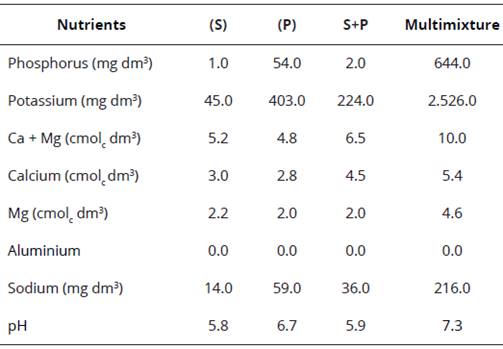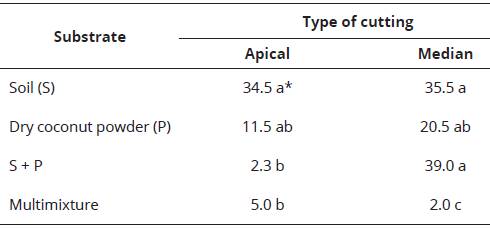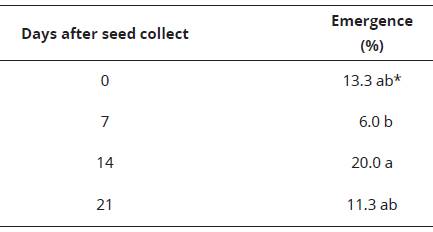Introduction
In Brazil, the Araripe Plateau has a prominence in the Brazilian Northeast due to its geomorphology, its tabuliform relief and altimetric levels that influenced the manifestation of distinct vegetation patterns (Cavalcanti and Nunes, 2002).
Native species richness attracts an intense anthropic activity that results in extinction risk for several forms of plants found there. One of the species that suffer the consequences of these actions is VaniUosmopsis arbórea, being that many populations of this species were decimated. The specie belonging to the family Asteraceae, of recognized economic potential. In the essential oil of its wood is present a substance known as α -bisabolol. By presenting antibacterial, antifungal and anti-inflammatory activities, this compound has been widely used in dermatological products. Studies are being carried out to promote the use of V. arborea oil as a substitute for that of chamomile in the cosmetics industry (Marco, 2015). In view that the essential oil content and percentage of α -bisabolol in V. arborea is higher than chamomile.
Nevertheless, little information is found in the literature on agronomic aspects that could contribute to the reduction of V. arborea extractivism. A path in this would be the establishment of a protocol to produce seedlings for the species and monitoring its survival in different environments. In establishing a protocol for seedling production of medicinal and aromatic species, the physiological quality of seeds and vegetative parts dictate the success of this system. For the manifestation of this good quality it is necessary to establish conditions for the germination, emergence of seeds and rooting of vegetative parts.
Despite the interest of several researchers in the propagation of wild species, there is still a lack of information regarding ideal germination conditions. This fact can be verified in the rules for seed analysis (Brasil, 2009), in which few prescriptions are found for the analysis of seeds of forest species.
An alternative for production of seedlings is the vegetative propagation, a method widely used in medicinal species, it is an important tool for the production improvement of woody and herbaceous species, being the starting point for any cultivation on a commercial scale (Costa et al., 2007). However, its viability depends on root formation capacity, quality of root system and plant ability to acclimatize (Bettoni et al., 2010).
The interest of the research has been concentrated on the verification of the best types and lengths of cuttings, on the effect of the use of growth regulators and on the substrates most suitable for rooting (Costa et al., 2007). Several authors have successfully use cuttings in medicinal and aromatic plants (Bona et al., 2005; Costa et al., 2007; Silva et al., 2011).
Regardless the propagation method used, it is important to evaluate substrates suitable for the development of each culture. Low density, good aeration and drainage of substrate is fundamental for root development in cuttings, to avoid the accumulation of moisture. In addition, absence of pathogens and essential nutrients content are some of the most important factors in the propagation of plants (Araújo et al., 2013).
Experiments that evaluate possible cultivation techniques of the species would contribute significantly to its domestication, allowing to repopulate degraded areas of the Araripe Plateau, besides providing technologies for its rational cultivation and consequent reduction of extractivism. Considering that research on V. arborea propagation is scarce, this work aims to assess the main methods of propagation and to evaluate seedlings development in different environments.
Material and methods
Seedlings Production of V. arborea by seeds
In the reproductive period, seeds from 20 plants of V. arborea found in the sedimentary slopes of the Araripe National Forest (FLONA), Crato-CE, Brazil, were collected. All seeds were taken to the Headquarters of Brazilian Institute of Environment and Renewable Natural Resources (IBAMA) situated in FLONA, where they were sown in different times (0, 7, 14 and 21 days after collect) in plastic trays of 23 x 30 cm, containing soil substrate from that region. The trays containing the seeds were arranged in two distinct environments (open sky and 50% shading fabric) during a period of 71 days, with watering twice a day, where the percentage of emergency was evaluated.
The experimental design was completely randomized in a 4 x 2 factorial scheme (four sowing seasons and two distinct environments), with three replications and twenty-five seeds per re- plicate, totaling 600 seeds. Sampling times were spaced at intervals of 7 days. Statistical analysis was performed using the program SISVAR/UFLA (Ferreira, 2011) and the comparisons between the means were performed by the Tukey test at 5% probability.
Vegetative propagation of V. arbórea
Substrate effect, cutting type and environment.
The experiment was conducted at the IBAMA Headquarters (FLONA), in a greenhouse. Medium and apical cuttings were used as treat- ments, with four leaves cut in half, 15 cm long and 3 to 5 mm in diameter. Each cutting received a bevel cut on the top and another cross on the base. They were cultivated in Styrofoam trays of 72 cells, containing four substrates: (1) soil removed from FLONA (S); (2) dry coconut powder (P); (3) S+P (1:1); (4) Multimixture (organic compound containing manure, dry coconut powder and carnaúba -Copernicia prunifera- residue, 1:1:1). Treatments were distributed in a completely randomized design in a 2 x 4 factorial scheme, which corresponded to two types of cuttings and four substrates in two replications with 72 cuttings per replicate.
Chemical analysis of each substrate was performed in the Soil-Water Laboratory of the Federal University of Ceará, Campus of Pici (Table 1). Irrigation was performed by nebulization, for two minutes, twice a day, being irrigated in the early morning and late afternoon.
Table 1 Fertility analysis of the evaluated substrates.

S= soil removed from FLONA. P = dry coconut powder.
After four months, the following variables were evaluated: number of live cuttings with callus (NLCC), number of rooted cuttings (NRC), fresh root matter weight (FRMW) and dry matter weight of root (DMWR) in grams. The leaf persistence and its correlation with rooting were also evaluated.
In order to study rooting, cuttings were made from 8 to 10 cm long and had a diameter among 3 to 5 mm, and planted in plastic trays in three planting positions: (1) vertical, (2) horizontal, (3) inclined; and in three different substrates: (1) soil obtained in FLONA (S), (2) S + P (1:1); (3) S and Caryocar coriaceum Wittm. Peel ground and dry in proportion 3:1. The design was completely randomized in a 3 x 3 factorial scheme, with three replications and four root cuttings per replicate, totaling 108 cuttings. Sixty days after planting, it was evaluated the number of live and rooted cuttings.
After four months, the following variables were evaluated: number of live cuttings with callus (NLCC), number of rooted cuttings (NRC), root fresh mass (RFM) and root dry mass (RDM). The leaf persistence was also evaluated and the correlation between this variable and rooting.
In order to evaluate the effect of the environment on the establishment of V. arbórea seedlings, these were transplanted to the experimental area available present at the IBAMA Headquarters, using a 1.5 x 1.5 m spacing in an environment corresponding to the natural habitat of the plants (forest clearing) without defined spacing. Seedlings development at different sites was evaluated by measuring every two weeks plants height for a four months period. Treatments were distributed in a completely randomized design with 12 replicates. Each replicate consisted of 10 individuals.
Statistical analisys
The statistical analyzes were performed with the aid of the SISVAR/UFLA program (Ferreira, 2011) and Tukey test at 5% probability was used for comparisons among means.
Results
Seedlings production of V. arbórea by seeds
There was no significant interaction among sowing time factors (0, 7, 14 and 21 days after seed collect) and two environments assessed (experimental area and their natural habitat). However, the only environment that had a significant difference between sowing times was in the open-air, in which the seeds were subject to the climatic oscillations, mainly of temperature and luminosity.
In the Araripe National Forest, Crato-CE, an environmental preservation area where the experiment was installed, the average temperature in the coldest month is greater than or equal to 18 °C and reaches approximately 34 °C on the driest days of the year (Lima et al., 2006). Dousseau et al. (2008) analyzing seed germination of Plantago tomentosa Lam. on the influence of temperature and light, concluded that regardless of the temperatures tested no germination was observed in the dark, being light an essential factor for the germination of this species.
In the open-air environment, the highest estímate of the emergence average of V. arbórea (20%) was found in the seeds that were sown 14 days after collect (Table 2), diífering statistically from seeds planted at 7 days after collect. Seeds collected at days zero and 21 do not differ from those sown at 14 days.
Vegetative propagation of V. arbórea
Substrate effect, cutting type and environment.
No difference was shown in the variance analysis among cutting and substrate type factors, except for the persistence of leaves at the cutting. Regarding the type of cutting, it was verified that there was no significant difference among the studied variables. The absence of significance among the types of cuttings evaluated (apical or median) allows inferring that any of them can be used for V. arborea propagation.
Even if it were not the case of the experiment in question, it is important to reaffirm the relevant role of the physiological condition of the cuttings in the rooting. Since along the branch, there is variation in the content of carbohydrates and promoting substances and inhibitors of the growth in the tissues, and the cuttings obtained from different portions of the branch tend, in general, to differ in the potential of rooting (Ehlert et al., 2004).
In Table 3 it was observed that the substrates used affect the number of live cuttings with callus (NLCC), number of rooted cuttings (NRC), root fresh mass (RFM) and root dry mass (RDM). It was observed that the soil of the habitat of this plant was the one that presented the best results, being followed by the results found by the mixture of this soil and dry coconut powder. This is justified for the fact of this substrate is the type of soil found in the natural habitat of the plant. This result is desirable because it reduces costs with the use of commercial substrates.
The multimixture was the substrate that showed inferior results to the others, not being a good alternative for the production of V. arbórea seedlings. Analyzing the fertility values of this (Table 1) it is verified that it presented high concentrations of P, K+, Ca2+ + Mg2+. Probably these high nutrient rates, added to the high sodium content, may have been detrimental to the rooting of V. arbórea cuttings. Oliveira et al. (2008), commented that substrates should be inexpensive, available near the region of consumption, present sufficient nutrient content, allow aeration and retention of moisture, as well as favor the physiological activity of the roots.
The basic pH (7.3) of the multimixture is also above that required by most native species. Lone et al. (2010), studying Rhododendron simsii Planch. rooting, emphasizes that the variation in the pH values exerts influence on the metabolism at the base of the cuttings, stimulating or inhibiting enzymatic processes that favor the dedifferentiation and differentiation of target cells, that will respond to the stimulus, originating the root origins. There are few works on V. arborea propagation and in those that exist it is verified that the species has difficulty of rooting by cutting (Cavalcanti and Nunes, 2002) justifying the low values found in all parameters analyzed.
Table 3 Effect of substrate on number of live cuttings with callus (NLCC), number of rooted cuttings (NRC), root fresh mass (RFM) and root dry mass (RDM) of V. arbórea.

*Means followed by the same letter, in the columns, do not differ by the Tukey test (P < 0.05).
For the leaf persistence variable, it was observed that for the apical stem type the soil substrate was the one that differed statistically from the others, revealing the best result, while the multimixture and soil mixed with coconut poder showed lower results. For the median cutting type, the soil and soil substrates mixed with dry coconut powder did not differ statistically from each other, showing better results. However, the multimixture differed from the other substrates, revealing lower results (Table 4).
Table 4 Effect of leaf persistence on rooting of V. arbórea cuttings with the use of different substrates.

*Means followed by the same letter, in the columns, do not differ by the Tukey test (P < 0.05).
There was a positive correlation of 76% between the permanence of the leaves on the cuttings and their rooting, indicating that the presence of leaves has a beneficial effect on rooting. The presence of the leaf in semi-woody cuttings is essential for the formation of new roots, since in the leaves occurs the production of carbohydrates by the photosynthesis, besides auxins and other substances necessary for the rooting (Hartmann et al., 2011). The results obtained in this experiment are supported by other studies, which verified the relationship between foliar retention and adventitious rooting (Pacheco and Franco, 2008).
Discussion
Seedlings production of V. arbórea by seeds
Vanillosmopsis arbórea seeds are small with average size of 2 mm, require more light for germinate, owning a positive photoblastic behavior, whose dormancy breakage is influenced by the accumulation and intensity of light required by this species. This can be verified by the variation of the percentage of germination only found in an open-air environment, being exposed for a longer time (14 days) and directly to this climatic factor. Some authors cite that pioneer species generally have orthodox seeds that germinate strategically over a longer or shorter period of time, which may vary by species (Figueiredo, 2008; Sarmento and Vilela, 2010).
Another factor that may have caused variations in V. arbórea seed germination is the temperature oscillations that are submitted during the day in an open environment and are less pronounced in a closed environment. According to Bewley and Baskin (1994) in most seeds the temperature changes the speed of water absorption and the metabolic reactions of the reserves necessary for the survival of seedlings.
The ecological significance of the relationship among seed size and light requirement and temperature fluctuation seems to be related to the need to avoid germination at very deep soil sites, where it is difficult for small seeds to emerge (Velten and Garcia, 2005), as it is the case of V. arbórea.
Vegetative propagation of V. arbórea
Substrate effect, cutting type and environment
Results obtained in this work indicate that there was no variation in rooting due to the type of cutting (median and apical). This result may have been caused by the absence of variation in the carbohydrate content and rooting promoting substances between the different portions of the plant branch, which were placed to root, because the physiological condition of the tissue along the branch can influence and interfere propagation of plants by cutting. For further research and as an alternative to the two cutting portions that did not diverge, it is suggested to include research with cuttings removed from the apical portion of the branches of the lamp for comparison with the types of cuttings studied in this work.
The treatments significance (different substrates) among the studied variables reaffirmed that the type of substrate used affected the process of root formation and corroborates with Kampf et al. (2006) and Lone et al. (2010b) when affirming that this exerts influence on the quality of the roots formed and the rooting percentage.
The highest values of the variables studied and related to the rooting of cuttings were found in the soil in which this native plant grows and develops. This result is of great importance, because there is a lack of information on the influence of edaphic attributes on the production process of seedlings of V. arborea.
The soil in which V. arborea is established and perpetuated is found in the Araripe National Forest (FLONA), an area of environmental preservation, with no evidence of erodibility, low slope and, therefore, rich in organic matter from the litter and without problems of compaction, which differentiates it qualitatively in relation to the other substrates used for all studied variables.
The maintenance of high soil quality indexes is a prerequisite for establishing the sustainability of any agricultural and/or forestry production system (Roverdderl et al., 2009). The quality of a forest based soil, such as the one used in this study, was confirmed by Cunha et al. (2003) when comparing the soil fertility with cultivated crops (wheat and corn), near and distant of native forest fragments and verified that the organic matter and calcium content was higher up to 10 m from the forest edge, reducing to the extent which increased the distance from the fragment.
For the leaf persistence variable, the results show that the presence of the leaf in light cuttings is a limiting factor for the adventitious rooting of the species and confirms the hypothesis that the foliar retention favors the adventitious rooting and, consequently, the survival of the cuttings (Hartmann et al., 2002).
Conclusions
It was concluded that the open-air environment provided a higher percentage of germination at 14 days after seed collection, which was the most favorable interval for seed germination of the seedlings. The cutting type did not affect the analyzed variables. The substrates only affected the number of rooted cuttings, and the soil from FLONA was the one that provided the best result.
At least one pair of leaves should be left on median piles during V. arbórea vegetative propagation. The seedlings developed better in experimental area indicating that V. arbórea is a plant that can be rationally exploited. It is recommended that for propagation of the species, other types of propagules should be tested, since there was no success with the use of root cuttings.















